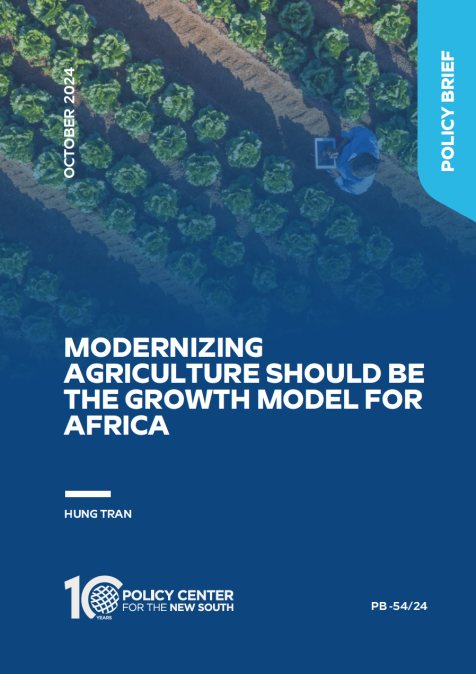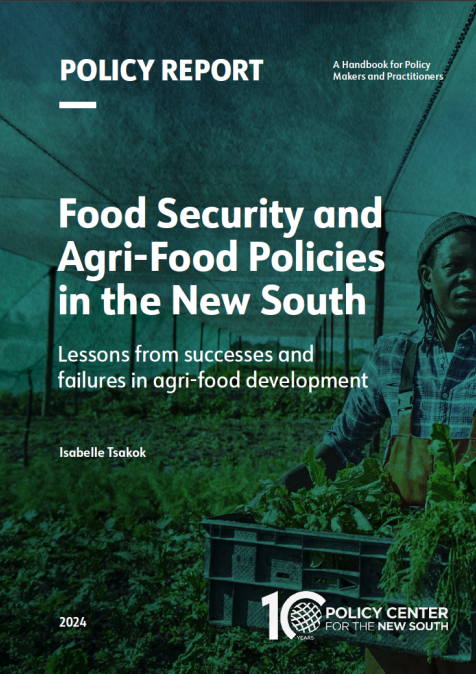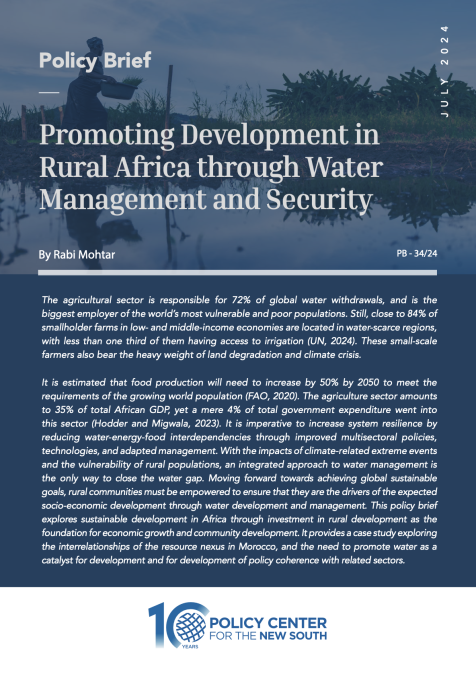Publications /
Policy Brief
China and India have become powerful incumbents in the manufacturing-for-exports and services-for-exports sectors, respectively. This has made it difficult for Africa, as a latecomer, to employ similar growth models for its own development. Given current geopolitical tension, its own comparative advantages and urgent needs, modernizing agriculture should be the growth model for Africa.
Introduction
Being behind in the international economic development derby, Africa has advantages and disadvantages in choosing an appropriate growth strategy. African countries can learn from the experiences of other countries that have applied different growth models to modernize their economies. For example, the East Asian Tigers (South Korea, Taiwan, Singapore, and Hong Kong), and then China, successfully employed the manufacturing-forexport model to develop their countries. By comparison, India has made much economic progress employing the business/IT services-for-export model. Those countries offer many lessons from which Africa can benefit in order to create the conditions that will encourage manufacturing and services.
The disadvantage facing Africa, however, is that those pioneering countries have become powerful incumbents in their chosen sectors, making it difficult for latecomers to compete and replicate their successes. Moreover, the current situation of geopolitical conflict and geoeconomic fragmentation—in particular heightened trade protectionism—have made relying on export as an engine of growth much more challenging than before. In the present circumstances, and looking at Africa’s comparative advantages and urgent needs, modernizing agriculture with the aim of producing increasing volumes of value-added agricultural products, could be the appropriate growth model.
The Importance of Growth Models: Lessons from the 1950s to 1970s
Developing countries must find ways to mobilize resources, both domestic and international, to increase capital and labor inputs to increase production of goods and services in the development of their economies. Economic models, or growth strategies, are important as frameworks to help governments prioritize efforts and focus policy measures to mobilize and channel resources to achieve defined growth objectives.
In the period immediately after the Second World War, two main models were pursued by developing countries: import substitution and export led growth strategies. At that juncture, many developing countries had just gained independence from Western colonial powers. Consequently a number of countries found the import-substitution approach politically attractive. These countries, many in Latin America, implemented industrial policies to create favorable conditions to support businesses that wanted to invest in manufacturing—mainly to the benefit of heavy industries such as steel and capital goods, with less emphasis on household consumer goods. Protectionist measures including tariffs were used to nurture infant industries, warding off competition from imports, as part of the incentives to promote the goal of self-sufficiency.
In that spirit, foreign direct investment (FDI) was not welcome, denying those countries opportunities to tap into the pool of international capital and knowhow to modernize their countries. From low bases after the Second World War, employing more capital and labor inputs did increase GDP during the 1960s and 1970s. For example, from 1965 to 1980, Indonesia grew by 10% per annum on average, Nigeria by 7%, and Brazil 6%. However, export-promoting countries grew more robustly: South Korea by 15%, and Taiwan by 12%. In the subsequent period from 1980 to 2010, manufacturing growth stalled, and became stagnant in many import-substituting countries.
By contrast, others, mainly in East Asia, adopted an export-led approach. They also used industrial policies to promote certain businesses, engaging in manufacturing for exports—which the U.S. allowed in order to secure the support of those countries for its efforts to contain the spread of communism in the region during the Vietnam War. The East Asian tigers were open to FDI to strengthen domestic companies via capital contributions, transfer of technology and knowhow, and by providing competitive discipline for local firms. They employed protectionist measures, but only in the initial stages, and reduced those measures as their exports grew. Having to compete in international markets was crucial for improving the products and productivity of those players, many of which attained international standards.
This approach helped those countries post growth stronger than the Latin American countries during the 1960s and 1970s. Importantly, manufacturing value added continued to grow solidly in the subsequent period from 1980 to 2010, compared with the stagnation observed in many import-substituting countries. Importantly, the East Asian countries were able to progress well beyond the Investment stage, then made good use of the Infusion stage in terms of learning from advanced production techniques through FDI and international competition (these stages are important for developing countries to go through, as explained in the World Bank’s World Development Report 2024). Some, such as South Korea, were able to continue advancing to the Innovation stage, having joined the group of high-income countries, while many others were caught in the middle-income trap.
The Importance of Growth Models: Lessons from the 1980s Onwards
From the 1980s onwards, the key lessons have been drawn by comparing the contrasting growth strategies of China and India.
China
Since Deng Xiaoping initiated China’s reform process in 1978, the country has opened up to attract FDI to modernize its enterprises—both state-and privately-owned—engaging in manufacturing goods for export, beginning with consumer goods then graduating to more sophisticated capital, and then high-tech goods. China grew very strongly by 9.5% per year on average for a forty-year period—1978 to 2018– lifting hundreds of millions of people out of poverty, before slowing down to around 5% at present because of demographic and other structural factors.
Importantly, China has become the manufacturing base for the world, dominating global supply chains especially for intermediate goods, critical materials, and green-energy products. In other words, it has become the sole manufacturing superpower, accounting for 35% of global manufacturing gross output, and 20% of world manufacturing exports. Importantly, China has also been the largest exporter of intermediate goods (such as components and parts to be assembled into finished products in importing countries, with intermediate goods making up half of world trade). Intermediate goods account for 65-75% of China’s exports to its key trading partners, including the U.S., Europe, Japan, and ASEAN countries. As a result, China has been able to embed itself even more deeply into global supply chains, despite trade protectionist measures being increasingly adopted by many Western countries. China has become irreplaceable in the global economy.
China has also diversified its trading partners for geopolitical reasons, exporting about 50% more to Global South countries than to developed countries in recent years, especially to those participating in the Belt and Road Initiative. By now, China trades more with Global South countries than with the U.S., Europe, and Japan combined. Consequently, the overcapacity problems China has created in many industrial sectors, from traditional/legacy areas such as steel and consumer goods, to high-tech/new energy products including EVs, solar panels, and wind power equipment, have become a formidable competitive challenge, not only to Western countries, but also to developing countries in their aspirations to industrialize their economies by learning from China’s experiences. On the other hand, competitively priced new energy products from China, such as solar panels, can help Africa in its green energy transition efforts.
India
By contrast, India has been slow in reforming and liberalizing its economy, which posted a lackluster annual growth rate of 3.1% from 1951 to 1979. As its reform process started to be implemented gradually, growth improved. It grew by 5.5% on average from the 1990s to the early 2000s, and is growing at around 6% at present. India has developed its service sector geared to exports, starting with global call centers that leverage its people’s fluency in English, and time zone differences with the U.S./Europe, then IT software including coding, and blossoming into global capacity centers that provide a wide range of back-office services to global companies, including R&D, accounting, and human resources. India’s services exports have grown substantially from $53 billion in 1995 to $338 billion in 2023–doubling the world service export growth rate. This is expected to grow to $800 billion, accounting for 11% of India’s GDP, by 2030.
It is important to note that India’s services exports account for almost 5% of world services exports, while its merchandise exports amount to 2% of world goods exports. Domestically, the services sector accounts for almost 55% of India’s gross value added, compared with 27.5% from industry, and 17.6% from agriculture. However, services contribute only 31% of India’s employment, insufficient to provide jobs to rising numbers of entrants to the labor force; this has become India’s Achilles’ heel. However, despite the unfavorable implications for job creation, many experts still argue for India to double down on services and services exports as a strategic engine of growth. Such a development would solidify India’s incumbency advantages in the global market for services exports, making it difficult for African countries to compete against India in these activities.
Lessons from China and India
In short, raising the share of manufacturing in gross value added and employment has supported strong economic growth, both at the aggregate level and on a per-capita basis, by increasing productivity and creating jobs for many unskilled workers. However, in recent decades, premature deindustrialization seems to have set in at lower levels of GDP per capita among developing countries, allowing services to gain more importance in driving economic growth, even if exportable services rely more on a relatively small number of workers with advanced skills, and thus do not create significant numbers of jobs for unskilled workers.
It is clear that Africa can examine and learn from the experiences of the Asian Tigers, and more recently, China and India, to adopt policies designed to develop its manufacturing and service industries, and especially to promote niche manufacturing sectors such as automobile in Morocco, diesel fuel and automotive in South Africa, and car and aircraft engine components and parts in Tunisia. However, Africa cannot rely on those sectors—like China did—to spearhead and drive the continent’s economic growth and job creation at the scale needed. The simple reason is that it is increasingly difficult to compete against powerful incumbents in these activities, in the context of geopolitical competition that has increased trade protectionism, —which used to be the engine for global growth. Instead, Africa should analyze its comparative advantages in the current international conditions of geopolitical contention, geoeconomic fragmentation, rising protectionism, and overcapacity in many manufacturing sectors, to select an appropriate growth model.
Africa’s Growth Model
Despite its huge potential, Africa is faced with a grim reality. Its GDP per capita amounts to only $1,960 at present—the lowest in the world, with the global average at $13,940. More distressingly, compared to advanced economies posting average GDP per capita of $58,260, the gap has widened recently against Africa. face acute food insecurity, a 159% increase since 2019, before the COVID-19 pandemic. Six hundred million people on the continent lack access to energy supply. It has to cope with 8-11 million of new young entrants to the labor force each year, but has been able to create only 3 million new formal jobs annually.
Moreover, Africa has suffered from the above-mentioned phenomenon of premature deindustrialization afflicting emerging markets and developing countries. This has been reflected in the transformation of Africa’s economy in the first two decades of the new millennium. The agricultural sector has experienced a decline in its share of employment from 58% to 49%, but maintains a 15% share of GDP. The extractive sector accounts for an unchanged 1% share of employment, with its contribution to GDP falling from 14% to 8%. The industrial sector has been stagnant: its employment share has increased marginally from 11% to 12%, but its GDP contribution fell from 21% to 20%. Most striking is the growth of the services sector: its employment share rose from 30% to 39%—having absorbed the surplus labor from agriculture—raising its GDP contribution from 50% to 56%. The problem is that the services sector has low productivity and slow productivity growth, unable to compete against the likes of India in the world market for services exports. Specifically, Africa’s share of global trade in digitally delivered services is a minuscule 0.9%—much lower than the continent’s share of around 3% of world goods exports and GDP.
Importantly, the data presented above should also be seen in the context of the fact that the informal economy—reflecting unregistered businesses and the unreported activities of informal workers—accounts for 83% of employment in Africa.
The challenge for Africa is to design a growth strategy that will alleviate the pressing problems of hunger and insufficient energy supply, while creating enough jobs to deal with rapid population growth, to create a tailwind instead of headwind for development, and to avoid problems of high unemployment and social unrest. At the same time, Africa has to raise the productivity of its workers to improve their living standards.
Against that reality, Africa’s comparative advantages are clearly in fully exploiting its potential in modernizing agriculture, complemented by increasing the value-added production of mineral resources and developing solar energy—key sectors that would address the main strategic needs of the continent at present. In addition, the early successes of digital and mobile payment services, such as in Kenya and other countries, can be leveraged to develop e-commerce on a continental basis—a development that can help transform Africa’s growth outlook.
Agriculture
Africa has 45% of the world’s arable land, and 60% of uncultivated arable land. Agriculture currently accounts for 15% of GDP and employs 49% of the workforce in Africa. However, because of the small size of farms, very low productivity, and the unbalanced mix of crops favoring fruit for export, Africa has to import more than 80% of its food from outside the continent, while nearly 60% of its population experiences food insecurity, either at moderate or severe level.
Against this backdrop, it is crucial to implement all measures to help farmers improve their productivity, by modernizing farming practices—which would raise total agricultural output as well as farmers’ incomes. The African Development Bank has estimated that Africa has the potential to increase agricultural output to $1 trillion by 2030, with agriculture becoming the core driver of its economic transformation.
Indeed, these are the aspirations contained in the Comprehensive African Agriculture Development Program (CAADP), launched in Maputo, Mozambique, in 2003, to prioritize food security and nutrition in the continent’s development efforts. The CAADP was reaffirmed by the Malabo Declaration in 2014, committing member countries to spend at least 10% of their annual budgets on agriculture and rural development, and to promote the growth of agriculture’s value added by 6% p.a. Disappointingly, by 2020 on average, only 2.1% of African countries’ budgets has been devoted to agriculture which has grown by 2.6% per year—but the progress on both targets remains well below the promised levels.
It is clear that African countries must redouble their efforts to realize the CAADP and the Malabo Declaration. Specifically, many long-standing impediments to agricultural development must be rectified. First, it is imperative to complete reform of the land-governance system to give farmers more security of land access, tenure, usufruct, and ownership rights. This would incentivize them to invest in their land and make use of modern farming techniques—including seed selections, fertilizers, irrigation, storage, and marketing—to improve their productivity and incomes. Moreover, these reforms would enable them to use their land rights as collateral to obtain financing—necessary to invest to improve yields.
In that context, efforts should be made to encourage farmers to increase the scale of their activities, mainly through cooperative initiatives including information dissemination, training, extension services, and forming cooperatives including for production, credit, and marketing activities. This is crucial to facilitate the application of modern farming techniques, including seed selection, crop planning, use of fertilizers, planting and harvesting, storage, and processing and making final marketable products. In particular, attention should be paid to implementing sustainable farming practices, dealing adequately with water shortage problems in many African countries.
One example of such cooperative initiatives is the success of Morocco’s —one of the world’s top five fertilizer exporters—which launched its Agribooster program in 2018, starting in Ghana before spreading to other countries. It aims to provide smallholder farmers with “inclusive and customized end-to-end solutions” to increase their yields and incomes. In its first year, the program assisted 168,404 farmers, increasing their yields by 33%. There should be an effort to launch more programs like this.
Moreover, modern technologies, such as mobile telephony and the internet, should be leveraged to develop inclusive rural credit systems and farmers’ marketing, distribution, and payment solutions.
In the process of development, land values will rise. It is important for the state to use regulation and taxation to capture a fair share of land value creation resulting from land reform, zoning changes, and improvements to fund economic development and climate transition efforts.
Promoting Intra-African Trade in Agriculture
The next step is to prioritize agriculture in the implementation of the African Continental Free Trade Agreement (AfCFTA, which entered into force in May 2019) by eliminating tariffs and other barriers to the export and import of agricultural goods, covering inputs (seeds, fertilizers, etc.), outputs (grains, other produce), and trade-facilitation services including cross-border payments. These measures are expected to accelerate intra-African trade in agriculture, which has grown by 6.2% p.a. in the past two decades—compared with Africa’s growth rate of 7.4% for agricultural imports from external sources, and 6% for exports to external destinations.
In the context of trade, it is also important to have a well thought-out plan to promote agricultural exports to key regions. Africa exports about $35 billion to $40 billion per year of agricultural products. Of this, 45% goes to Western Europe, 20% to South and East Asia, 10% to the Middle East, and 5% to North America. The EU is a large but difficult market for Africa, mainly because of the EU’s Common Agricultural Policy (CAP), in place since 1962 and designed to protect and support domestic producers through common tariffs and financing, as well as non-tariff barriers. The amount of subsidy has been estimated to be €42 billion ($50 billion) per year, giving European producers unfair advantages against foreign producers, especially African producers. The recently introduced Carbon Border Adjustment Mechanism (CBAM) would erect more barriers to African goods. Moreover, thought has to be given to how to deal with anti-GMO regulations and consumer sentiment in Europe, in a context in which using biotechnology, possibly involving genetically modified seeds, could improve African agricultural yields. On the other hand, the EU has launched a variety of programs to help African countries to address food insecurity, sustainable agriculture, integration of farmer organizations into global supply chains, and innovation. The African Union should collaborate with the EU to streamline those programs to make them more effective.
U.S.-Africa goods trade amounts to more than $60 billion per year, of which less than 10% is in agricultural products. The core of the U.S. economic engagement with Africa is the African Growth and Opportunity Act (AGOA), enacted in 2020. This Act gives duty-free access to the U.S. market for over 1800 African products, in addition to the more than 5000 products eligible for duty-free access under the General System of Preferences (GSP). So far, 32 countries are eligible for AGOA benefits, having met rigorous conditions, including making continual progress toward a market-based economy, the rule of law, political pluralism, combating corruption, protecting human rights, and eliminating barriers to U.S. trade and investment. There is legislation pending in the US Congress to re-authorize AGOA until 2041.
Against that backdrop, Africa should pay attention to realizing China’s commitment at the second Forum on China-Africa Agricultural Cooperation in November 2023 to raise the agricultural trade volume between the two from $9 billion in 2023 to $20 billion in 2030. Given that China has been the largest trading partner for Africa, to the tune of more than $280 billion per year, and is the largest food importing country—accounting for almost 13% of world food imports—there is a lot of potential for African agricultural products in China.
Developing Complementary Sectors to Absorb Surplus Agricultural Labor
Improving agricultural productivity will release labor from that sector. Therefore it is important to develop complementary sectors to create employment to absorb the surplus agricultural labor.
Value-added Mineral Products
Africa is endowed with plentiful of mineral resources, accounting for 30% of the world’s mineral reserves including most of the critical minerals needed for the transition to green energy, such as cobalt, manganese, copper, graphite, and lithium. It is important to note that green energy products require many times more critical minerals than traditional ones. The climate transition effort has been turned into a strategic undertaking by the heightened geopolitical tensions—with the U.S., EU, and China competing to ensure reliable supply chains for those minerals for their economic and national security. Africa should seize the opportunity to move downstream from mineral extraction to processing and manufacturing, in the process raising domestic value added and creating needed jobs. It can exploit the competition between the West and China to obtain more favorable investment contracts, including the transfer of technology and knowhow to move up the value chain. This will require better coordination among African governments and businesses when dealing with foreign entities, perhaps facilitated by a strengthened African Minerals Development Center. From a policy perspective, Africa can examine Indonesia’s mineral strategy for useful pointers.
In 2019, Indonesia banned exports of raw nickel, which had accounted for 42.3% of the world’s supply. In 2020, it updated the Indonesia Mining Law to attract and facilitated FDI in mid- and downstream activities to capture more benefits for the central government. This strategy has produced some results. Between 2019 and 2022, investment in mineral processing and manufacturing in Indonesia increased threefold from $3.56 billion to $10.96 billion, far exceeding investment in extraction. Prior to 2014, Indonesia had two nickel smelters in operation. By 2023, there were 43 smelters in operation, 28 under construction, and 24 more in the planning process. China has been the driving force behind the stepped-up investment in this area. Those operations have helped promote economic activity in the region, including by creating jobs.
Develop Solar-based Energy
According to the IMF, about half of Africa’s population has no access to electricity. Those who do pay nearly twice as much as consumers elsewhere in the world. Meanwhile, power shortages cost the continent 2% to 4% of GDP each year. Africa’s energy mix is heavily dependent on fossil fuels, even though it is regarded as the ‘sun continent’ with 60% of the world’s solar resources. As the costs of solar and wind power have declined substantially in recent years, becoming affordable—for example it is estimated that solar power costs will fall by 77% from 2010-2008—Africa should accelerate the implementation of various solar energy projects to significantly increase the share of solar energy in the power mix, creating new jobs in the process.
Of particular interest is the use of solar-powered water pumps by small farms to irrigate their 1-2 acre lots from rivers, lakes, or boreholes. These pumps replace diesel or petrol pumps, which cost more and add to carbon emissions. By doing so, for example, small-scale farmers—most of whom are women—in Kenya’s Rift Valley have been able to increase their yields and incomes, bettering their quality of life. The availability of competitively priced solar panels made in China could help promote this development.
Many solar power plants—including both photovoltaics and concentrated solar power—have been established in Africa. The largest is the 580 MW Ouarzazate Solar Power plant in Morocco, but the remainder of the top ten solar power stations are in South Africa.
With adequate investment in transmission grids, Africa can export solar power to Europe, which needs urgently to diversify its energy supply sources, especially for renewable energy. It would be a significant win-win approach to the energy transition for both continents. For example, Morocco has already exported solar energy to Europe via two existing power lines connected to Spain. In addition, the megaproject is under consideration to lay the longest high-voltage submarine cables for 2,300 miles from the Moroccan desert to southwest England—meeting up to 8% of the UK’s electricity needs.
The Potential of e-Commerce
The success of mobile money services and the payment platform M-Pesa—first started in Kenya but since spreading to seven countries with 50 million active users every month—as well as Fawry in Egypt, and Interswitch in Nigeria, has launched a vibrant fintech ecosystem in Africa. This can be leveraged to provide digital platforms for e-commerce throughout the continent, helping to transform Africa’s economic prospects by opening up new opportunities for businesses and employment.
More generally speaking, the UN Development Program (UNDP) has found that digitalization has contributed to efficiency and productivity gains in the world’s informal economies, including unregistered micro and small businesses and informal workers. The informal economy employs 60% of workers worldwide, and up to 90% in the poorest regions. In particular, about 83% of employment in Africa is informal. Digitalization or e-commerce can help by raising the visibility of informal businesses and workers, providing them with access to new markets, and expanding their networks, improving their delivery and services, helping to increase their productivity and raise their incomes. In the context of Africa, these activities and their potential can directly address the key problems of low formal employment and high levels of poverty. As a consequence, developing e-commerce should be part of Africa’s growth strategy.
Conclusion
Developing and implementing a growth strategy of modernizing agriculture, including by realizing the 2014 Malabo commitments to devote 10% of countries’ annual budgets to agriculture to help it grow by at least 6% p.a., would transform Africa’s economic prospects, helping the continent to grow more robustly and sustainably. Fundamentally, implementing that strategy would address the key factors that are keeping productivity low in Africa—the main reason the continent remains poor—by accelerating the accumulation of capital, improving resource allocation, and finding ways and opportunities to better use its human resources, reversing the brain drain Africa has long suffered. Many components of that strategy are parts of AfCFTA—especially the liberalization of intra-African trade in agriculture. As a consequence, the rigorous and timely implementation of AfCFTA throughout the continent would be the best way to help realize that growth model in the foreseeable future. The roadmap is clear. What is needed now is the political will of African leaders to ‘just do it’.











